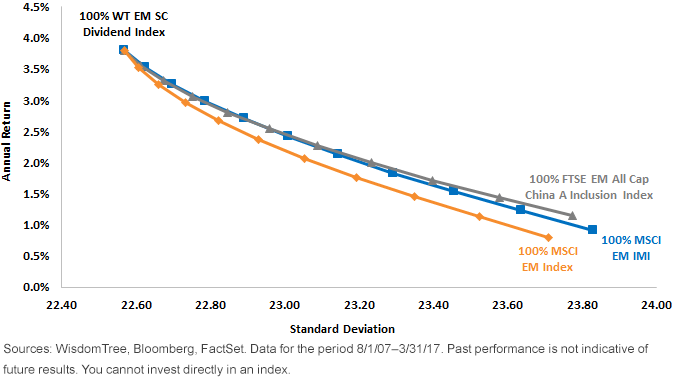Is Your EM Allocation Complete?


Emerging market (EM) equities sold off sharply following the election of Donald Trump last November, perhaps owing to the protectionist rhetoric and tough trade talk from the president-elect. With that, the MSCI Emerging Markets Index fell 4.2% in the final quarter of 2016, breaking a streak of four consecutive positive quarters.
That sell-off represented a pause in the party, but certainly not the end of it. After the fourth quarter’s breather, EM came roaring back in the first quarter of 2017, returning 11.5%—capping the best quarter for the asset class in five years.
A core tenet of behavioral finance is that flows tend to follow performance. There are currently nearly 1,800 U.S.-listed exchange-traded funds (ETFs),1 and the one that took in the most money in the first quarter of 2017 happened to be an EM ETF, raking in over $6.6 billion.2 Given that EM ETFs represent a relatively small portion of the ETF universe (currently representing a combined $166 billion in total assets, about $75 billion less than the largest U.S.-focused ETF), this fund’s perch at the top of the list is quite impressive.
Finding Gaps in Portfolio Construction
As we consult with our clients about how to best optimize their model portfolios, a few interesting trends typically emerge. We’ve found that many investors include U.S. small-cap stocks in their models, but fewer tend to include international small caps, and even fewer include EM small caps.
To us, this is the opposite of how we recommend building portfolios, and we believe it represents a massive gap within a complete model. We believe that when it comes to portfolio construction, specific to emerging markets, a larger allocation to small-cap stocks is merited.
Benefits of Small Caps That Are Unique to EM
Going beyond the obvious small-cap premium, there are several reasons why we have such strong conviction in EM small caps.
Smaller, more domestically oriented companies will typically conduct more of their business in their local markets. This is an organic way to access the much-desired rise of the EM middle class consumer theme—which McKinsey referred to as “the biggest growth opportunity in the history of capitalism3”—without being constrained to just the two consumer sectors.
Further, although the anti-trade rhetoric has eased in recent weeks, the possibility of a trade war exists for as long as the Trump administration remains in office. Due to their local focus, small caps are much less reliant on strong global growth demand and are thus more insulated from many hypothetical trade battles.
A specific risk to EM is that many cap-weighted indexes and ETFs are heavily tilted toward large state-owned enterprises. These companies can be managed inefficiently and do not always have the interests of shareholders at the top of their list of priorities (consider a hypothetical government-run company trying to simultaneously balance maximizing both profits and employment). Investing in companies with smaller market caps will largely avoid many of these large, unproductive enterprises.
Not Just Any Small-Cap Will Suffice
Lastly, one thing that we’ve discovered during our firm’s history is that our dividend-weighted approach tends to make the greatest difference in lesser-efficient markets, particularly in mid- and small caps. Analyzing global public equity markets, EM small caps could arguably be the least efficient of them all.
Our WisdomTree Emerging Markets SmallCap Dividend Index (WTEMSC) was launched on August 1, 2007. Indeed, not only has it outperformed both the broad MSCI Emerging Markets Index as well as the MSCI Emerging Markets Small Cap Index since its inception, but it has done so with less volatility than both.
Therefore, we believe that investors shouldn’t just own EM small-cap stocks—they should own small-cap dividend payers.
Are Investors Accessing These Benefits?
The MSCI Emerging Markets Index has just 1.5% in small caps, so ETFs and active managers that are closely tied to the index are hardly reaping in the benefits we just reviewed. The ETF that led all funds in flows in the first quarter tracks the MSCI Emerging Markets Investable Market Index, an index that includes the investable universe of EM equities and has more exposure to small-cap stocks (a total of 12.4%).
While this is an improvement over the MSCI Emerging Markets Index, we do not believe that it goes far enough, and that a dedicated allocation to WTEMSC is justified.
The Impact of Implementing WTEMSC in Model Portfolios
A hypothetical blended portfolio of the MSCI Emerging Markets Investable Market Index with WTEMSC would have historically experienced increased returns and reduced volatility, regardless of the size of the allocation. As shown in the chart below, for every additional 10% allocation that the WisdomTree Index represented, the risk and return profile of the portfolio was enhanced.
This also holds true when blending WTEMSC with the underlying indexes of the two largest U.S.-listed EM ETFs: the FTSE Emerging Markets All Cap China A Inclusion Index and the MSCI Emerging Markets Index.

Additionally, even with its strong historical performance, the current fundamentals underpinning WTEMSC make it a very attractive option. Given the 4.17% dividend yield of WTEMSC (as opposed to MSCI Emerging Markets Investable Market Index’s 2.32%4) and the relatively lower valuations of the WisdomTree Index (13.1x P/E vs. 15.1x5), each marginal percentage allocation toward WTEMSC has the impact of boosting an investor’s dividend yield and reducing their portfolio’s valuations.
With investors coming back into EM in droves, many would be wise to consider small-cap dividend payers as a complement to their allocation. The list of benefits of adding WTEMSC is long, and given the macroeconomic forces that support it, we strongly believe it can be an effective tool for investors looking to complete their EM allocations.
Unless otherwise noted, data source is Bloomberg, as of March 31, 2017.
1Morgan Stanley, as of 3/31/17.
2Bloomberg, as of 3/31/17.
3Yuval Atsmon, Peter Child, Richard Dobbs, and Laxman Narasimhan, “Winning the $30 Trillion Decathlon: Going for Gold in Emerging Markets,” McKinsey, 8/12.
4WisdomTree, FactSet, as of 3/31/17.
5WisdomTree, FactSet, as of 3/31/17.
Important Risks Related to this Article
Investments in emerging, offshore or frontier markets are generally less liquid and less efficient than investments in developed markets and are subject to additional risks, such as risks of adverse governmental regulation and intervention or political developments.

